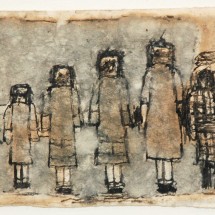James Castle (American, 1899–1977)
 In 1899 in rural Idaho, James Castle was born deaf; he would never learn to sign, or truly to read or to write, but rather communicated daily through his art. These works, on discarded letters, cardboard, or the remnants of books, journals, and boxes illustrate Castle’s life and his surroundings. From interiors to exteriors, we can see Castle’s homes, other homesteads, figures, animals, buildings, and common objects. Beyond his many drawings, Castle’s opus also includes three-dimensional paper-crafts (often of people and birds) and collages. Castle’s most frequently used medium, resembling traditional charcoal, is a solution of stove soot and spit, and with his collages Castle regularly soaked and ground construction and crepe paper in water or saliva to acquire colored pigments. These latter creations are commonly referred to as “pulp” paintings. He preferred his own natural, intimate processes to traditional art materials. Stylistically Castle’s works are diverse, at times appearing as simple abstractions of environments, and at others they’re astutely realistic.
In 1899 in rural Idaho, James Castle was born deaf; he would never learn to sign, or truly to read or to write, but rather communicated daily through his art. These works, on discarded letters, cardboard, or the remnants of books, journals, and boxes illustrate Castle’s life and his surroundings. From interiors to exteriors, we can see Castle’s homes, other homesteads, figures, animals, buildings, and common objects. Beyond his many drawings, Castle’s opus also includes three-dimensional paper-crafts (often of people and birds) and collages. Castle’s most frequently used medium, resembling traditional charcoal, is a solution of stove soot and spit, and with his collages Castle regularly soaked and ground construction and crepe paper in water or saliva to acquire colored pigments. These latter creations are commonly referred to as “pulp” paintings. He preferred his own natural, intimate processes to traditional art materials. Stylistically Castle’s works are diverse, at times appearing as simple abstractions of environments, and at others they’re astutely realistic.
Castle did receive some attention before his death. In the 1950s Castle’s nephew, Bob Beach, took his works to art professors in Portland, Oregon. As a result of this exposure, Castle’s art was exhibited regionally until his death in 1977, when, overwhelmed by his growing popularity and their loss, his family denied access to his works until 1998. Now, Castle’s work can be found in private and public collections nationwide.
- Untitled (5 Sisters)
- Construction (3 figures)


